A Case Study on the Convection Initiation Mechanisms of an Extreme Rainstorm over the Northern Slope of Kunlun Mountains, Xinjiang, Northwest China
Abstract
:1. Introduction
2. Data and Methodology
2.1. Dataset
2.2. Methodology
3. Case Overview
3.1. Introduction to the Rainfall Event
3.2. Environmental Conditions
4. Evaluation of Simulation
5. Convection Initiation
6. Discussion
7. Conclusions
- (1)
- The persistence of mesoscale cloud clusters with TBB ≤ −35 °C for about 3 h gave rise to persistent rainfall in the vicinity of Pishan County on the northern slope of KLM. Subsequently, the cloud clusters were influenced by a mesoscale vortex and moved towards the northwest edge of the Tarim Basin.
- (2)
- An upper-level jet (ULJ) at 200 hPa and a shortwave trough at 500 hPa delivered favorable conditions for the CI and convection development of the rainstorm event in the mid–higher level of the troposphere. In addition, the combined convergent lifting located at the leading edge of a cold pool (CP) and a boundary layer jet (BLJ) in the low level below ~1 km AGL played an important role for the CI.
- (3)
- Further investigations based on the MPV revealed that significant atmospheric instability indicated by strong negative MPV values (up to ~−12 PVU) appeared near the leading edge of CP, and the windward slope was influenced by BLJ before the heavy precipitation. As rainfall cloud clusters developed, the unstable energy was released (revealed by the significant decrease in both size and intensity of the negative MPV).
- (4)
- During the early stage, the main unstable energy on the windward slope was convective instability (CIns, up to ~−12 PVU) and conditional symmetric instability (CSI, up to ~−10 PVU). The CIns played a significant role below ~3 km ASL near the leading edge of the CP, while the CSI made a certain contribution in the 3–5 km ASL height above the CP. During the CI period, the both size and intensity of the CIns significantly decreased compared to the situation before the CI, while CSI still retained relatively high values (up to ~−10 PVU) above the CP, providing favorable conditions of unstable energy for the CI of rainfall cloud clusters.
- (5)
- The frontogenetical forcing features associated with the CI showed that the total frontogenesis was mainly dominated by the slantwise term. At the early stage, in addition to the slantwise term (up to ~10−6 K m−1 s−1), the diabatic heating term also contributed weakly along the leading edge of CP, while the convergence and deformation term had weak contributions. By the time of the CI period, besides the slantwise term, the diabatic heating term played an important role within the rainfall cloud cluster (i.e., about 2–5 km ASL), and the convergence had significant contributions at the bottom of the rainfall cloud clusters. The convergence is induced at the leading edge of the CP and the orographic blocking effect. Additionally, the slantwise term was commonly determined by the horizontal gradience of vertical velocity () and the vertical gradient of potential temperature (). At the CI time, the contribution of was greater than that of .
Supplementary Materials
Author Contributions
Funding
Data Availability Statement
Acknowledgments
Conflicts of Interest
References
- Marengo, J.A.; Alcantara, E.; Cunha, A.P.; Seluchi, M.; Nobre, C.A.; Dolif, G.; Goncalves, D.; Assis Dias, M.; Cuartas, L.A.; Bender, F.; et al. Flash Floods and Landslides in the City of Recife, Northeast Brazil after Heavy Rain on May 25–28, 2022: Causes, Impacts, and Disaster Preparedness. Weather Clim. Extrem. 2023, 39, 100545. [Google Scholar] [CrossRef]
- Masson-Delmotte, V.; Zhai, P.; Pirani, A.; Connors, S.L.; Péan, C.; Berger, S.; Caud, N.; Chen, Y.; Goldfarb, L.; Gomis, M.I. Climate Change 2021: The Physical Science Basis; Cambridge University Press: Cambridge, UK, 2021; Volume 2. [Google Scholar]
- Oguz Altunel, A.; Kara, F. Tracing the Culprits over the Destruction of Three Coastal Communities during a Rouge Rainstorm on August 2021 in North Central Türkiye. Ocean Coast. Manag. 2023, 241, 106630. [Google Scholar] [CrossRef]
- Nanditha, J.S.; Kushwaha, A.P.; Singh, R.; Malik, I.; Solanki, H.; Chuphal, D.S.; Dangar, S.; Mahto, S.S.; Vegad, U.; Mishra, V. The Pakistan Flood of August 2022: Causes and Implications. Earths Future 2023, 11, e2022EF003230. [Google Scholar] [CrossRef]
- Li, Z.; Abulikemu, A.; Zhu, K.; Mamtimin, A.; Zeng, Y.; Li, J.; Abulimiti, A.; Kadier, Z.; Abuduaini, A.; Li, C.; et al. Diurnal Variation Characteristics of Summer Precipitation and Related Statistical Analysis in the Ili Region, Xinjiang, Northwest China. Remote Sens. 2023, 15, 3954. [Google Scholar] [CrossRef]
- Terry, J.P.; Al Ruheili, A.; Almarzooqi, M.A.; Almheiri, R.Y.; Alshehhi, A.K. The Rain Deluge and Flash Floods of Summer 2022 in the United Arab Emirates: Causes, Analysis and Perspectives on Flood-Risk Reduction. J. Arid. Environ. 2023, 215, 105013. [Google Scholar] [CrossRef]
- Dalagnol, R.; Gramcianinov, C.B.; Crespo, N.M.; Luiz, R.; Chiquetto, J.B.; Marques, M.T.A.; Neto, G.D.; de Abreu, R.C.; Li, S.; Lott, F.C.; et al. Extreme Rainfall and Its Impacts in the Brazilian Minas Gerais State in January 2020: Can We Blame Climate Change? Clim. Resil. Sustain. 2022, 1, e15. [Google Scholar] [CrossRef]
- Chalov, S.; Platonov, V.; Erina, O.; Moreido, V.; Samokhin, M.; Sokolov, D.; Tereshina, M.; Yarinich, Y.; Kasimov, N. Rainstorms Impacts on Water, Sediment, and Trace Elements Loads in an Urbanized Catchment within Moscow City: Case Study of Summer 2020 and 2021. Theor. Appl. Climatol. 2023, 151, 871–889. [Google Scholar] [CrossRef]
- Huang, W.; Feng, S.; Chen, J.; Chen, F. Physical Mechanisms of Summer Precipitation Variations in the Tarim Basin in Northwestern China. J. Clim. 2015, 28, 3579–3591. [Google Scholar] [CrossRef]
- He, X.; Abulikemu, A.; Mamtimin, A.; Li, R.; Abulimiti, A.; An, D.; Aireti, M.; Zhou, Y.; Sun, Q.; Li, Z.; et al. On the Mechanisms of a Snowstorm Associated with a Low-Level Cold Front and Low-Level Jet in the Western Mountainous Region of the Junggar Basin, Xinjiang, Northwest China. Atmosphere 2023, 14, 919. [Google Scholar] [CrossRef]
- Abulikemu, A.; Xu, X.; Wang, Y.; Ding, J.; Wang, Y. Atypical Occlusion Process Caused by the Merger of a Sea-Breeze Front and Gust Front. Adv. Atmos. Sci. 2015, 32, 1431–1443. [Google Scholar] [CrossRef]
- Abulikemu, A.; Xu, X.; Wang, Y.; Ding, J.; Zhang, S.; Shen, W. A Modeling Study of Convection Initiation Prior to the Merger of a Sea-Breeze Front and a Gust Front. Atmos. Res. 2016, 182, 10–19. [Google Scholar] [CrossRef]
- Abulikemu, A.; Ming, J.; Xu, X.; Zhuge, X.; Wang, Y.; Zhang, Y.; Zhang, S.; Yu, B.; Aireti, M. Mechanisms of Convection Initiation in the Southwestern Xinjiang, Northwest China: A Case Study. Atmosphere 2020, 11, 1335. [Google Scholar] [CrossRef]
- Ukkonen, P.; Manzato, A.; Mäkelä, A. Evaluation of Thunderstorm Predictors for Finland Using Reanalyses and Neural Networks. J. Appl. Meteorol. Climatol. 2017, 56, 2335–2352. [Google Scholar] [CrossRef]
- Chen, G.; Zhao, K.; Lu, Y.; Zheng, Y.; Xue, M.; Tan, Z.-M.; Xu, X.; Huang, H.; Chen, H.; Xu, F. Variability of Microphysical Characteristics in the “21· 7” Henan Extremely Heavy Rainfall Event. Sci. China Earth Sci. 2022, 65, 1861–1878. [Google Scholar]
- Chen, X.; Zhang, F.; Zhao, K. Diurnal Variations of the Land–Sea Breeze and Its Related Precipitation over South China. J. Atmos. Sci. 2016, 73, 4793–4815. [Google Scholar]
- Zhang, S.; Parsons, D.B.; Xu, X.; Wang, Y.; Liu, J.; Abulikemu, A.; Shen, W.; Zhang, X.; Zhang, S. A Modeling Study of an Atmospheric Bore Associated with a Nocturnal Convective System over China. J. Geophys. Res. Atmos. 2020, 125, e2019JD032279. [Google Scholar] [CrossRef]
- Zhang, S.; Parsons, D.B.; Xu, X.; Sun, J.; Wu, T.; Abulikemu, A.; Xu, F.; Chen, G.; Shen, W.; Liu, L. Dynamics Governing a Simulated Bow-and-Arrow-Type Mesoscale Convective System. Mon. Weather Rev. 2023, 151, 603–623. [Google Scholar]
- Bai, L.; Meng, Z.; Huang, Y.; Zhang, Y.; Niu, S.; Su, T. Convection Initiation Resulting from the Interaction between a Quasi-stationary Dryline and Intersecting Gust Fronts: A Case Study. J. Geophys. Res. Atmos. 2019, 124, 2379–2396. [Google Scholar] [CrossRef]
- Lin, G.; Grasmick, C.; Geerts, B.; Wang, Z.; Deng, M. Convection Initiation and Bore Formation Following the Collision of Mesoscale Boundaries over a Developing Stable Boundary Layer: A Case Study from PECAN. Mon. Weather Rev. 2021, 149, 2351–2367. [Google Scholar] [CrossRef]
- Du, Y.; Chen, G.; Han, B.; Bai, L.; Li, M. Convection Initiation and Growth at the Coast of South China. Part II: Effects of the Terrain, Coastline, and Cold Pools. Mon. Weather Rev. 2020, 148, 3871–3892. [Google Scholar]
- Kirshbaum, D.J.; Adler, B.; Kalthoff, N.; Barthlott, C.; Serafin, S. Moist Orographic Convection: Physical Mechanisms and Links to Surface-Exchange Processes. Atmosphere 2018, 9, 80. [Google Scholar] [CrossRef]
- McMurdie, L.A.; Rowe, A.K.; Houze, R.A.; Brodzik, S.R.; Zagrodnik, J.P.; Schuldt, T.M. Terrain-Enhanced Precipitation Processes Above the Melting Layer: Results From OLYMPEX. J. Geophys. Res. Atmos. 2018, 123, 12194–12209. [Google Scholar] [CrossRef] [PubMed]
- Mulholland, J.P.; Nesbitt, S.W.; Trapp, R.J. A Case Study of Terrain Influences on Upscale Convective Growth of a Supercell. Mon. Weather Rev. 2019, 147, 4305–4324. [Google Scholar] [CrossRef]
- Xu, W.; Zipser, E.E.; Chen, Y.L.; Liu, C.; Liou, Y.C.; Lee, W.C.; Jou, B.J.D. An Orography-Associated Extreme Rainfall Event during TiMREX: Initiation, Storm Evolution, and Maintenance. Mon. Weather Rev. 2012, 140, 2555–2574. [Google Scholar] [CrossRef]
- Wei, P.; Xu, X.; Xue, M.; Zhang, C.; Wang, Y.; Zhao, K.; Zhou, A.; Zhang, S.; Zhu, K. On the Key Dynamical Processes Supporting the 21.7 Zhengzhou Record-Breaking Hourly Rainfall in China. Adv. Atmos. Sci. 2023, 40, 337–349. [Google Scholar] [CrossRef]
- Kang, Y.; Peng, X.; Wang, S.; Hu, Y.; Shang, K.; Lu, S. Observational Analyses of Topographic Effects on Convective Systems in an Extreme Rainfall Event in Northern China. Atmos. Res. 2019, 229, 127–144. [Google Scholar] [CrossRef]
- Rao, X.; Zhao, K.; Chen, X.; Huang, A.; Hu, S.; Hu, D.; Liu, X. Roles of Multi-Scale Orography in Triggering Nocturnal Convection at a Summer Rainfall Hotspot Over the South China Coast: A Case Study. J. Geophys. Res. Atmos. 2022, 127, e2022JD036503. [Google Scholar] [CrossRef]
- Fu, P.; Zhu, K.; Zhao, K.; Zhou, B.; Xue, M. Role of the Nocturnal Low-Level Jet in the Formation of the Morning Precipitation Peak over the Dabie Mountains. Adv. Atmos. Sci. 2019, 36, 15–28. [Google Scholar] [CrossRef]
- Hua, S.; Xu, X.; Chen, B. Influence of Multiscale Orography on the Initiation and Maintenance of a Precipitating Convective System in North China: A Case Study. J. Geophys. Res. Atmos. 2020, 125, e2019JD031731. [Google Scholar] [CrossRef]
- Abulikemu, A.; Wang, Y.; Gao, R.; Wang, Y.; Xu, X. A Numerical Study of Convection Initiation Associated With a Gust Front in Bohai Bay Region, North China. J. Geophys. Res. Atmos. 2019, 124, 13843–13860. [Google Scholar] [CrossRef]
- Zheng, J.; Abulikemu, A.; Wang, Y.; Kong, M.; Liu, Y. Convection Initiation Associated with the Merger of an Immature Sea-Breeze Front and a Gust Front in Bohai Bay Region, North China: A Case Study. Atmosphere 2022, 13, 750. [Google Scholar] [CrossRef]
- Li, N.; Jiao, B.; Ran, L.; Gao, Z.; Gao, S. Influence of the Upstream Terrain on the Formation of a Cold Frontal Snowband in Northeast China. Asia Pac. J. Atmos. Sci. 2022, 58, 243–264. [Google Scholar] [CrossRef]
- Li, R.; Wang, X.; Yang, X.; Zhou, J. Study on Formation Mechanism of a Summer Cold Sector Torrential Rainfall. Chin. J. Meteorol. Mon. 2019, 45, 50–60. [Google Scholar]
- Cui, X.; Chen, M.; Qin, R.; Han, L. Research Advances in the Convective Initiation Mechanisms. Chin. J. Meteorol. Mon. 2021, 47, 1297–1318. [Google Scholar]
- Liu, L.; Ran, L.; Gao, S. Evolution of Instability before and during a Torrential Rainstorm in North China. Adv. Atmos. Sci. 2016, 33, 110–120. [Google Scholar] [CrossRef]
- Shou, S. Mesoscale Atmospheric Dynamics; Higher Education Press: Beijing, China, 2009. [Google Scholar]
- Huang, X.; Zhou, Y.; Ran, L.; Kalim, U.; Zeng, Y. Analysis of the Environmental Field and Unstable Conditions on A Rainstorm Event in the Ili Valley of Xinjiang. Chin. J. Atmos. Sci. 2021, 45, 148–164. [Google Scholar] [CrossRef]
- Kong, M.; Abulikemu, A.; Zheng, J.; Aireti, M.; An, D. A Case Study on Convection Initiation Associated with Horizontal Convective Rolls over Ili River Valley in Xinjiang, Northwest China. Water 2022, 14, 1017. [Google Scholar] [CrossRef]
- Hu, S.; Xerinay, T.; Li, N.; Ran, L.; Chang, Y. Comparative Analysis of Two Extreme Rainstorms in the Arid Area of Western South Xinjiang. Chin. J. Atmos. Sci. 2022, 46, 1177–1197. [Google Scholar] [CrossRef]
- Zeng, Y.; Zhou, Y.; Yang, L. A Preliminary Analysis of the Formation Mechanism for a Heavy Rainstorm in Western Xinjiang by Numerical Simulation. Chin. J. Atmos. Sci. 2019, 43, 372–388. [Google Scholar] [CrossRef]
- Zhuang, X.; Zhao, J.; Li, B.; Zhang, Y. Characteristics of Water Vapor Source and Transport during Rainstorm in Western Southern Xinjiang. Chin. J. Torrential Rain Disasters 2021, 41, 544–555. [Google Scholar]
- Xie, Z.; Zhou, Y.; Yang, L. Review of Study on Precipitation in Xinjiang. Chin. J. Torrential Rain Disasters 2018, 37, 204–212. [Google Scholar] [CrossRef]
- Skamarock, W.C.; Klemp, J.B.; Dudhia, J.; Gill, D.O.; Liu, Z.; Berner, J.; Wang, W.; Powers, J.G.; Duda, M.G.; Barker, D.M. A Description of the Advanced Research WRF Version 4; NCAR: Boulder, CO, USA, 2019; Volume 145. [Google Scholar]
- Hong, S.-Y.; Noh, Y.; Dudhia, J. A New Vertical Diffusion Package with an Explicit Treatment of Entrainment Processes. Mon. Weather Rev. 2006, 134, 2318–2341. [Google Scholar] [CrossRef]
- Jiménez, P.A.; Dudhia, J.; González-Rouco, J.F.; Navarro, J.; Montávez, J.P.; García-Bustamante, E. A Revised Scheme for the WRF Surface Layer Formulation. Mon. Weather Rev. 2012, 140, 898–918. [Google Scholar] [CrossRef]
- Chen, F.; Dudhia, J. Coupling an Advanced Land Surface–Hydrology Model with the Penn State–NCAR MM5 Modeling System. Part I: Model Implementation and Sensitivity. Mon. Weather Rev. 2001, 129, 569–585. [Google Scholar] [CrossRef]
- Iacono, M.J.; Delamere, J.S.; Mlawer, E.J.; Shephard, M.W.; Clough, S.A.; Collins, W.D. Radiative Forcing by Long-lived Greenhouse Gases: Calculations with the AER Radiative Transfer Models. J. Geophys. Res. Atmos. 2008, 113, D13103. [Google Scholar] [CrossRef]
- Ran, L.; Li, N.; Gao, S. Diagnostic Analysis of Precipitating Convective Process in East China with Moist Baroclinic Vorticity Parameters. Chin. J. Atmos. Sci. 2013, 37, 1261–1273. [Google Scholar]
- Liu, L.; Ran, L.; Zhou, Y.; Gao, S. Analysis on the Instability and Trigger Mechanism of Torrential Rainfall Event in Beijing on 21. Chin. J. Atmos. Sci. 2015, 39, 583–595. [Google Scholar]
- Liu, J.; Zhou, Y.; Yang, L.; Zeng, Y.; Liu, W. The Instability and Its Trigger Mechanism of Extreme Precipitation Event in the Yili River Valley on 31 July 2016. Chin. J. Atmos. Sci. 2019, 43, 1204–1218. [Google Scholar] [CrossRef]
- Liu, J.; Liu, Z.; Zhang, J.; Liu, F.; Li, J.; Zeng, Y.; Tong, Z.; Jiang, Y.; Yang, L.; Zhou, Y. Comparison of Convective Triggering Mechanisms of Typical Rainstorm Events in the Hami Area of East Tianshan Mountains. Chin. J. Atmos. Sci. 2022, 46, 965–988. [Google Scholar] [CrossRef]
- Xu, Y.; Wu, S.; Yang, W.; Liu, X.; Huang, Y. Analysis of Frontogenesis and Circulation Characteristics of the Meiyu Front with Heavy Precipitation in Zhejiang Province. Chin. J. Atmos. Sci. 2019, 43, 1219–1232. [Google Scholar] [CrossRef]
- Ninomiya, K. Large-and Meso-u-Scale Characteristics of Meiyu/Baiu Front. J. Meteorol. Soc. Jpn. 2000, 78, 141–157. [Google Scholar] [CrossRef]
- Yang, S.; Gao, S.; Lu, C. Investigation of the Mei-Yu Front Using a New Deformation Frontogenesis Function. Adv. Atmos. Sci. 2015, 32, 635–647. [Google Scholar] [CrossRef]
- Wang, Z.; Ding, Y.; Zhang, Y.; Tian, L.; Li, J. Analysis of Convective-Symmetric Instabilities and Frontogenesis in a convective Rain Band on the Northwest Edge of WPSH. Chin. J. Atmos. Sci. 2014, 38, 133–145. [Google Scholar]
- Duolaiti, X. Formulation of Precipitation Intensity Standard of Xinjiang. Chin. J. Desert Oasis Meteorol. 2005, 28, 7–8. [Google Scholar]
- Tang, P.; Huang, Y.; Zhang, L.; Chen, T.; Yang, X. Causation Analysis of An Extreme Torrentaial Rain Onthe Slope of Middle Kunlun Mountains. Chin. J. Desert Oasis Meteorol. 2022, 16, 34–41. [Google Scholar]
- Sun, Y.; Zhou, Y.; Wang, Y. Analysis of Dynamic Process and Moisture Source on a Heavy Precipitation Event in Southern Xinjiang Associated with the Double Upper-Level Jet. Chin. J. Atmos. Sci. 2019, 43, 1041–1054. [Google Scholar] [CrossRef]
- Jiao, B.; Ran, L.; Li, S.; Zhou, K. Diagnosis of the Mesoscale Vortex Development Mechanism in a Heavy Rain Event. Chin. J. Atmos. Sci. 2022, 46, 762–774. [Google Scholar] [CrossRef]
- Zhou, K.; Ran, L.; Cai, R.; Qu, T.; Chen, L. Diagnostic Analysis of Terrain Following Vertical Motion Equation in Southern Xinjiang Extreme Rainstorms. Chin. J. Atmos. Sci. 2022, 46, 745–761. [Google Scholar] [CrossRef]
- Li, R.; Li, J.; Wang, J.; Sun, M.; Zhao, K. Dynamic and Thermal Structure Characteristics of the rainstorms in the West of South Xinjiang. Chin. J. Arid. Land Geogr. 2018, 41, 9–16. [Google Scholar]
- Zhang, Y.; Li, H.; Lin, X.; Abulimiti; Yu, B. Analysis of Continuous Rainstorm Circulation Background Anthe Dynamic Process of Synoptic Scale in West of Southern Xinjian. Chin. J. Meteorol. Mon. 2015, 41, 816–824. [Google Scholar]
- Yin, G.; Zhang, Z.; Zhu, B.; Li, Q.; Mao, M.; Xing, W.; Hu, Z.; Chen, X. Characteristics and Physical Mechanisms of a Rainstorm in Hotan, Xinjiang, China. Front. Environ. Sci. 2022, 10, 46882. [Google Scholar] [CrossRef]
- Zhang, D.L.; Cho, H.R. The development of negative moist potential vorticity in the stratiform region of a simulated squall line. Mon. Weather Rev. 1992, 120, 1322–1341. [Google Scholar] [CrossRef]
- Wu, G.; Cai, Y.; Tang, X. Moist potential vorticity and slantwise vorticity development. Acta Meteorol. Sin. 1995, 53, 387–405. (In Chinese) [Google Scholar]
- Yao, X.; Gao, Y.; Ma, J. MPV-Q⁎ view of vorticity development in a saturated atmosphere. Atmos. Res. 2020, 244, 105058. [Google Scholar] [CrossRef]
- Gao, S.T.; Lei, T.; Zhou, Y. Moist potential vorticity anomaly with heat and mass forcings in torrential rain systems. Chin. Phys. Lett. 2002, 19, 878–880. [Google Scholar] [CrossRef]
- Schultz, D.M.; Schumacher, P.N. The use and misuse of conditional symmetric instability. Mon. Weather Rev. 1999, 127, 2709–2732. [Google Scholar] [CrossRef]
- Ullah, K.; Gao, S. A diagnostic study of convective environment leading to heavy rainfall during the summer monsoon 2010 over Pakistan. Atmos. Res. 2013, 120, 226–239. [Google Scholar] [CrossRef]
- Du, Y.; Zhang, Q.; Chen, Y.; Zhao, Y.; Wang, X. Numerical simulations of spatial distributions and diurnal variations of low-level jets in China during early summer. J. Clim. 2014, 27, 5747–5767. [Google Scholar] [CrossRef]
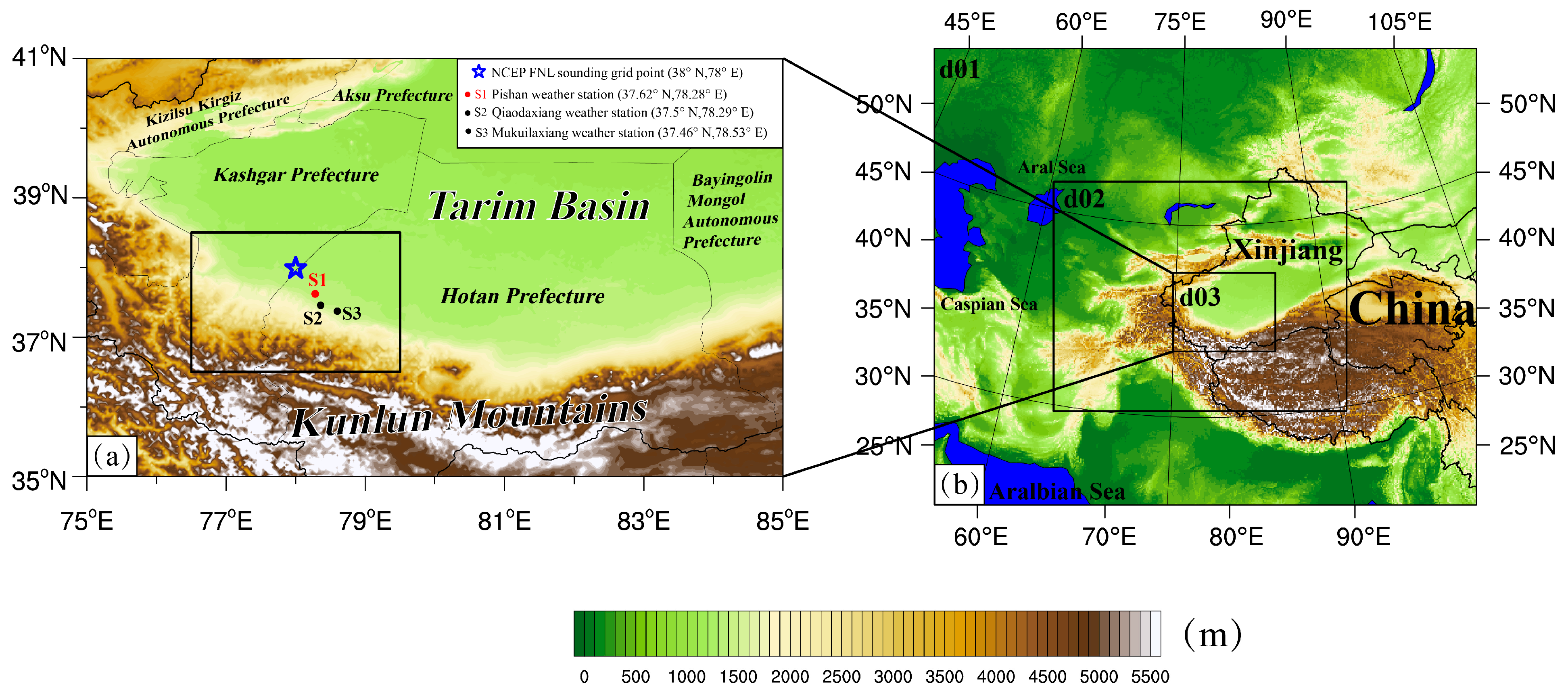
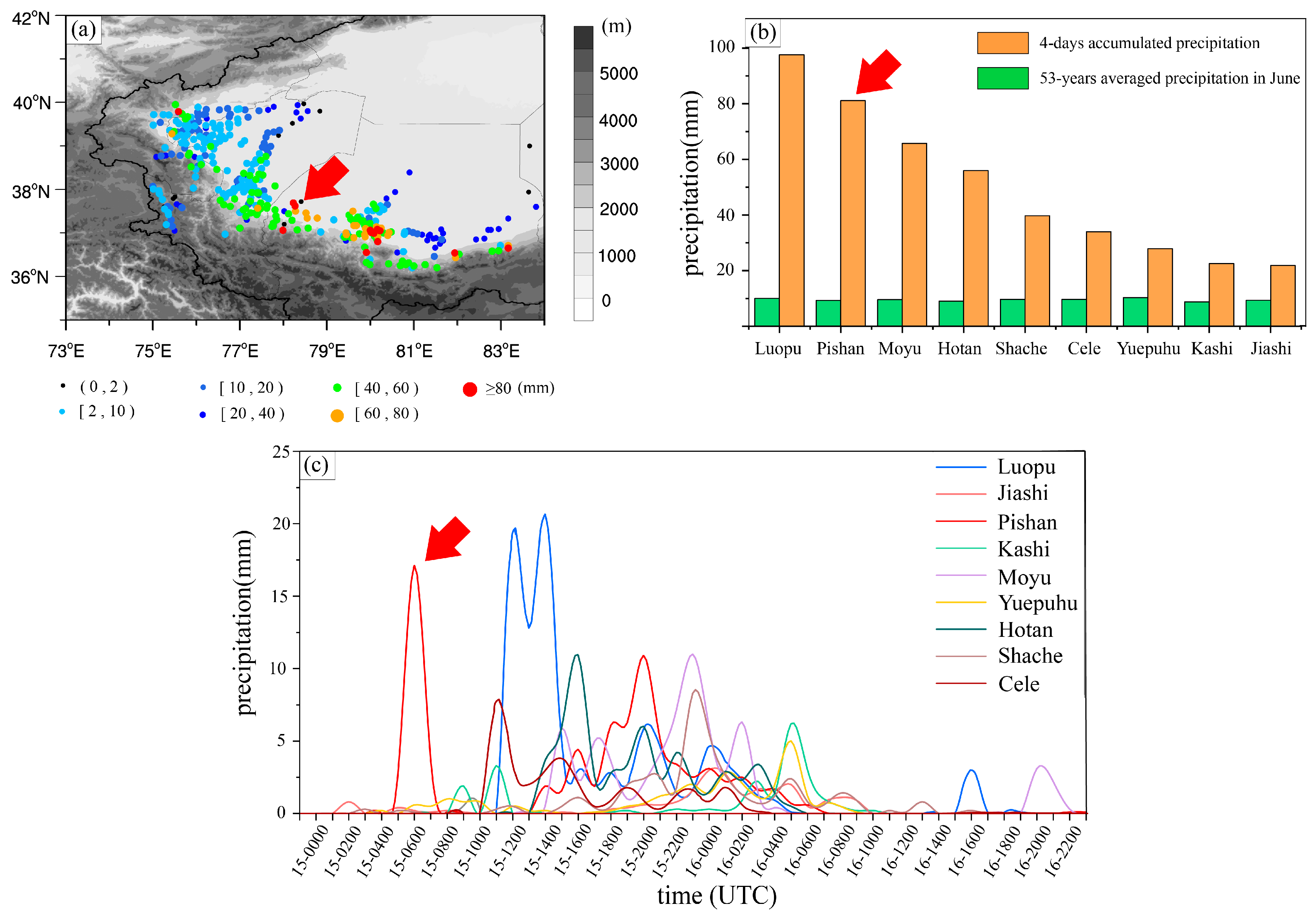
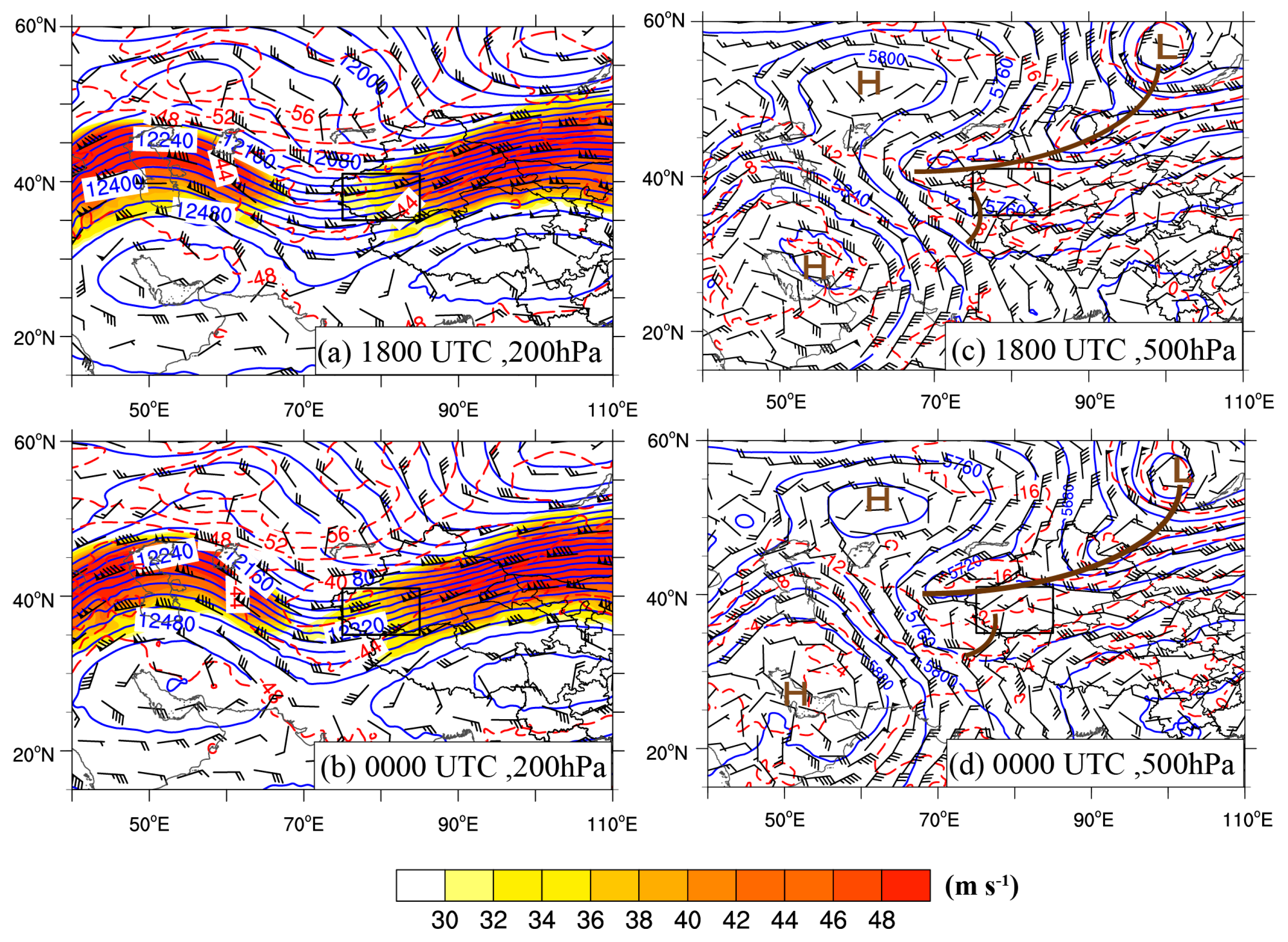
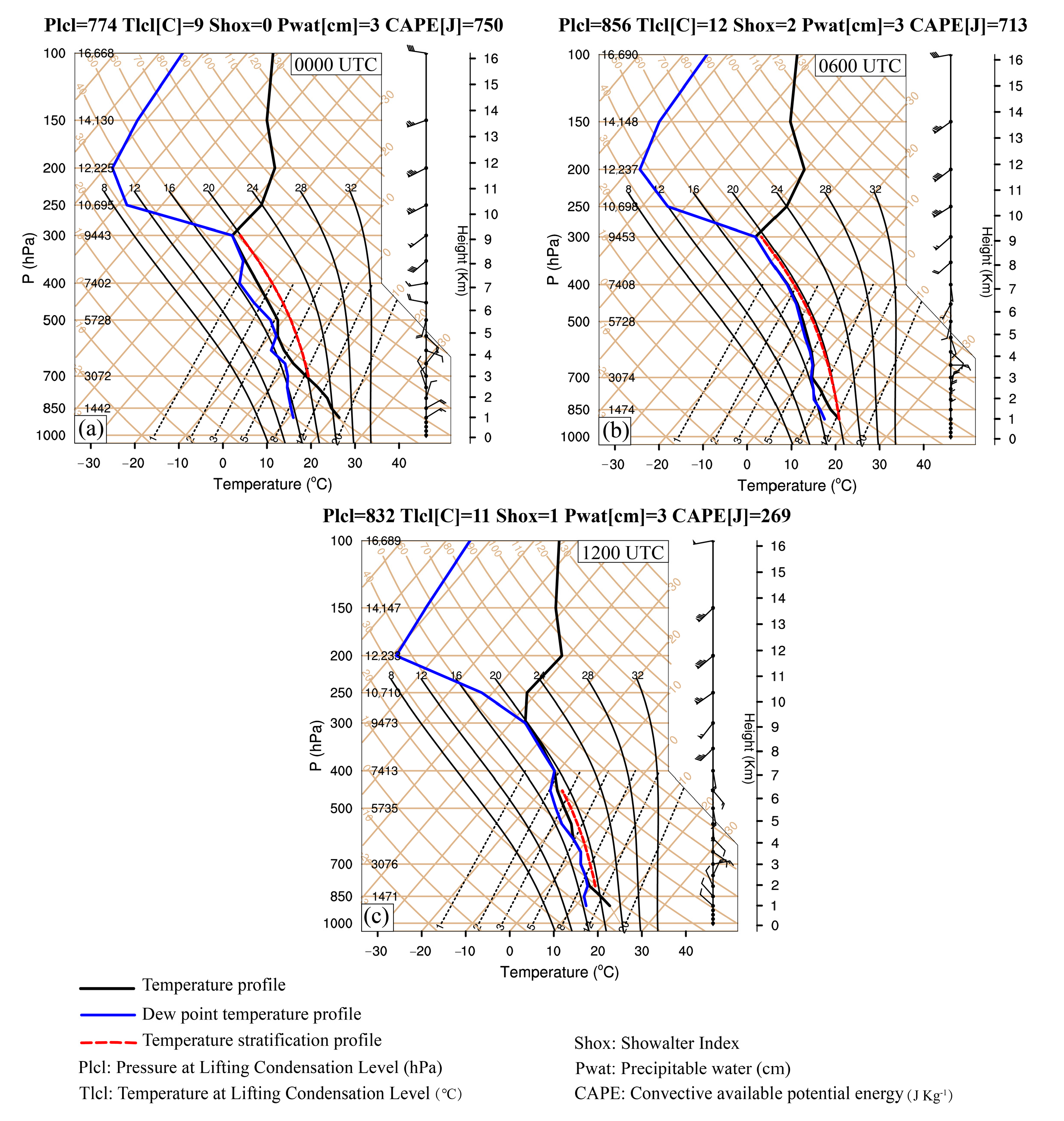


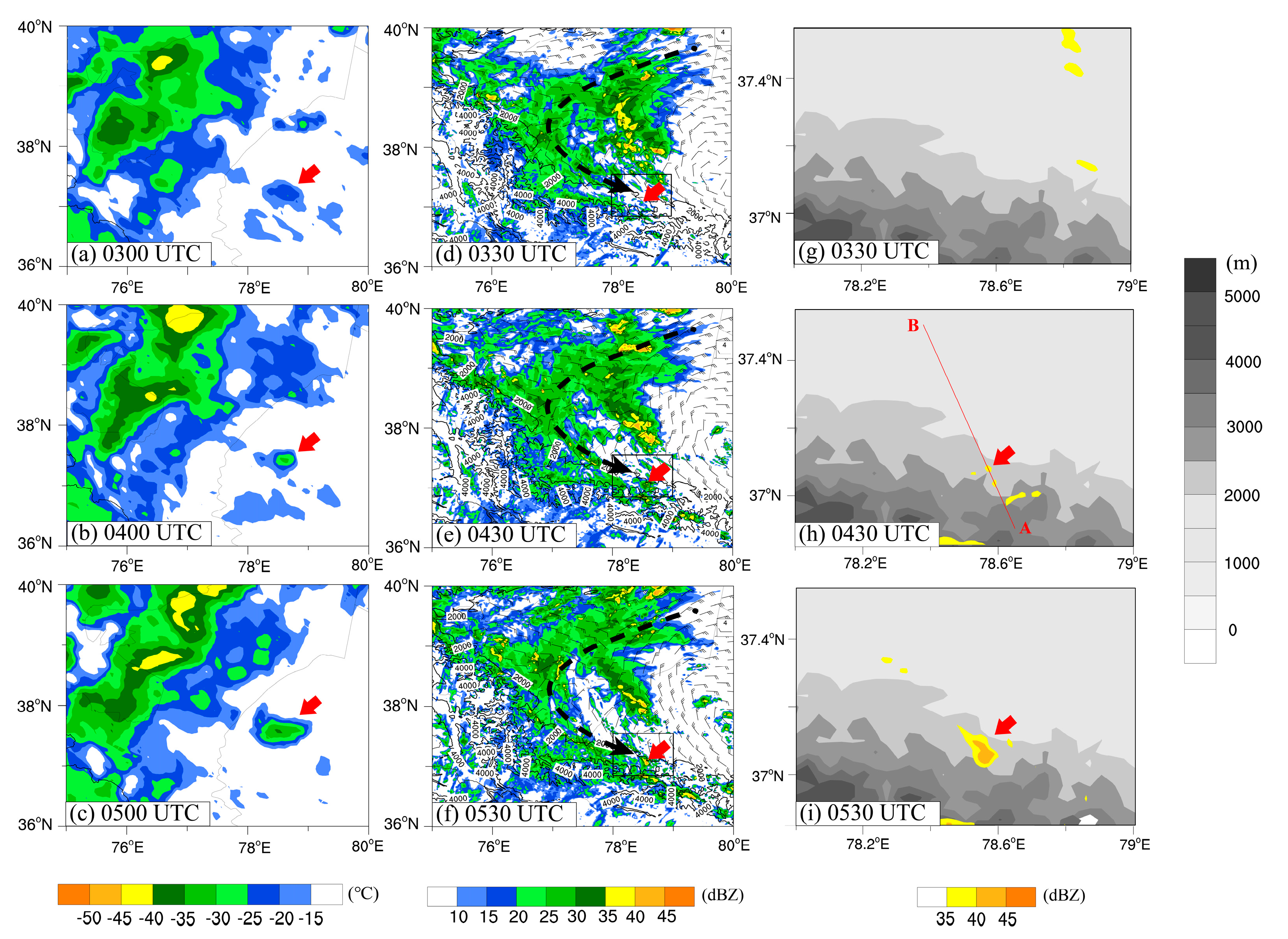
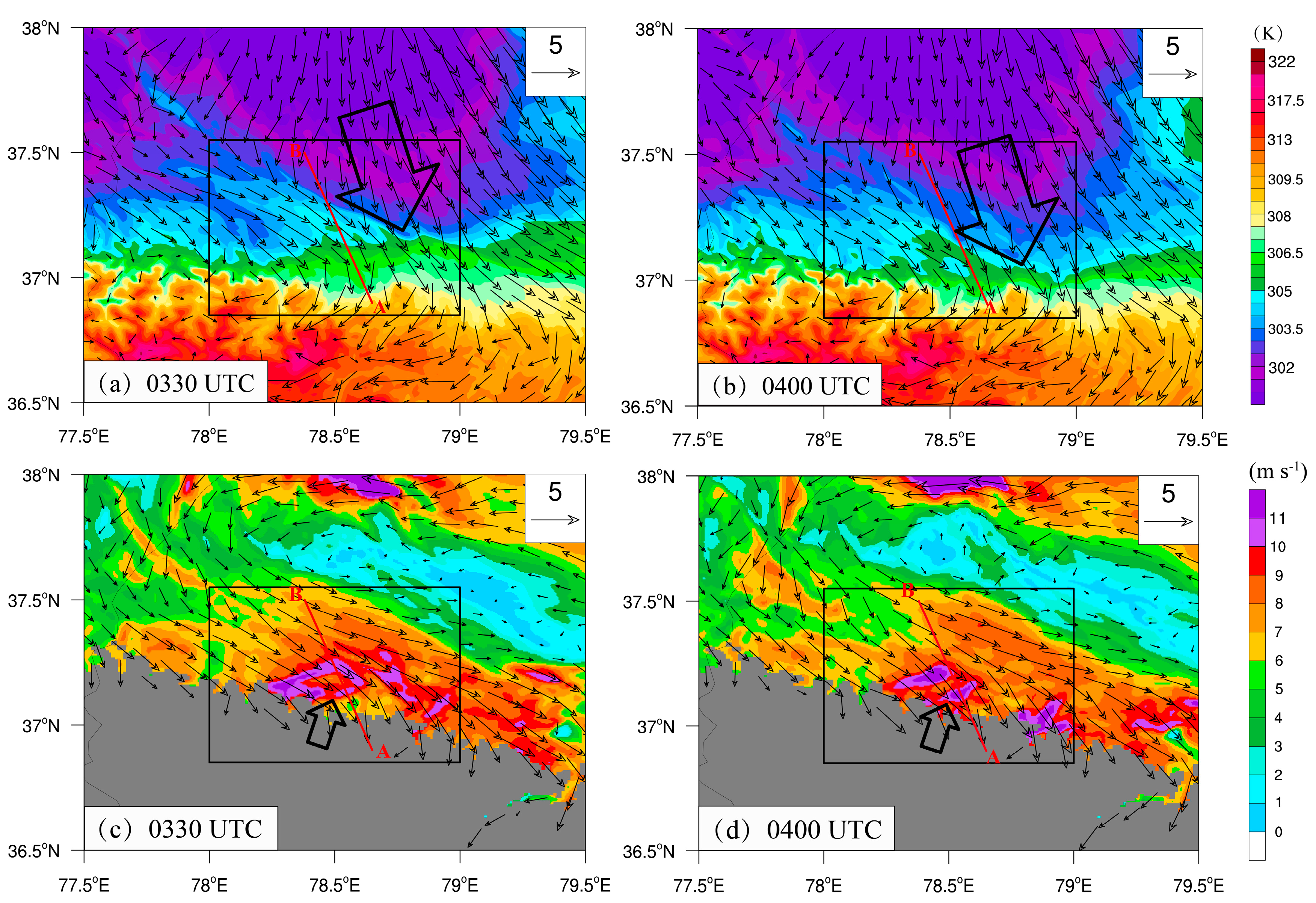

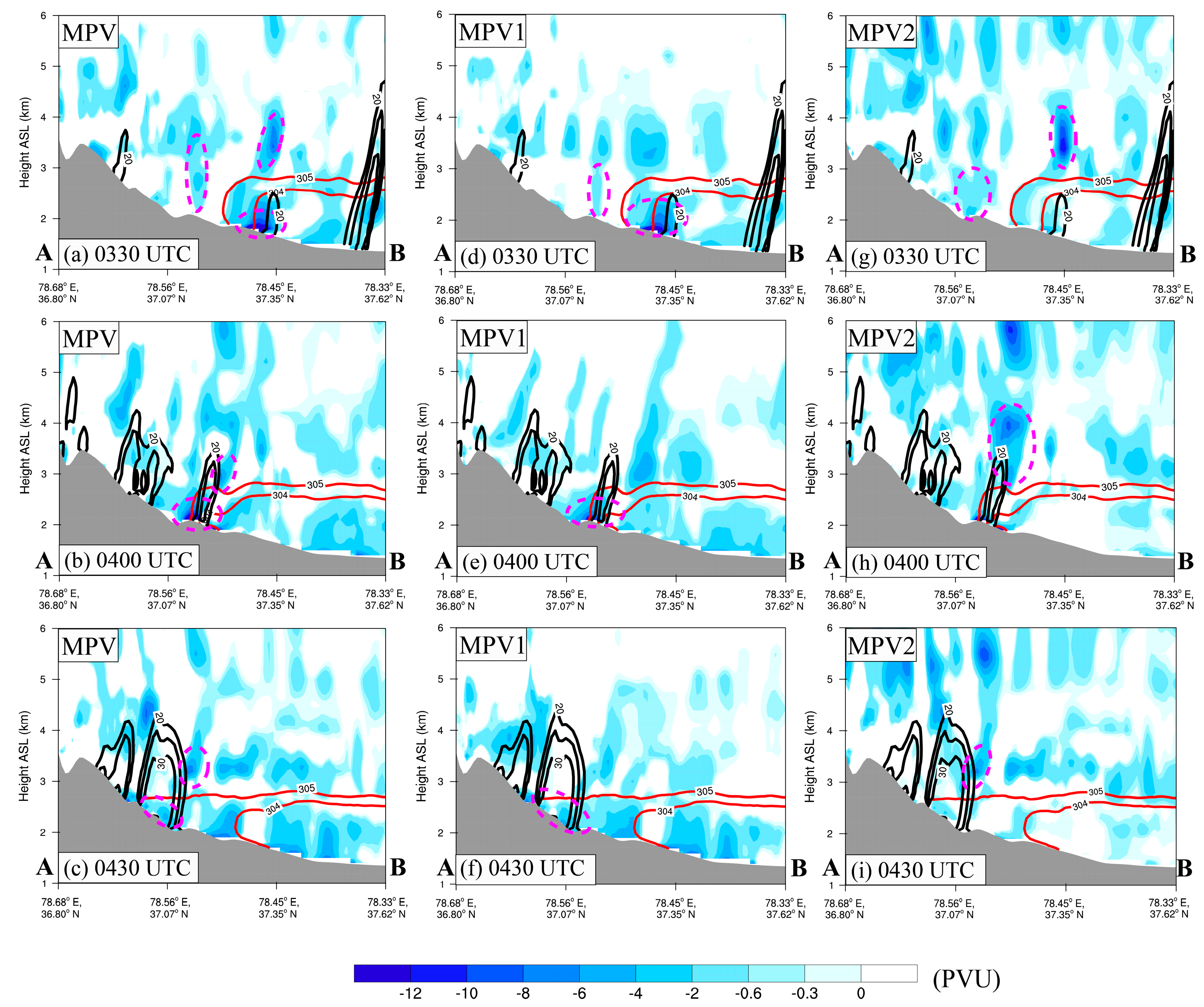
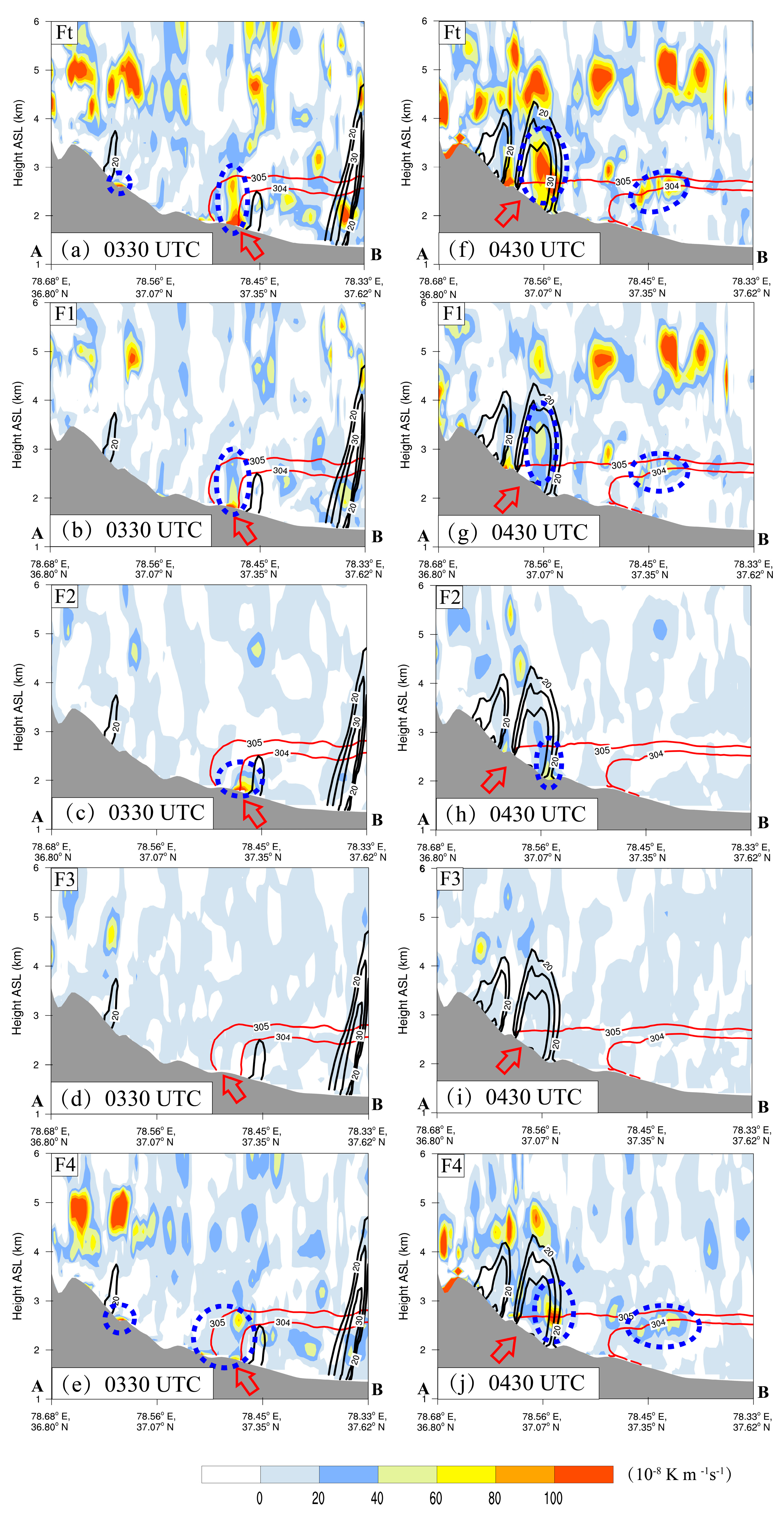
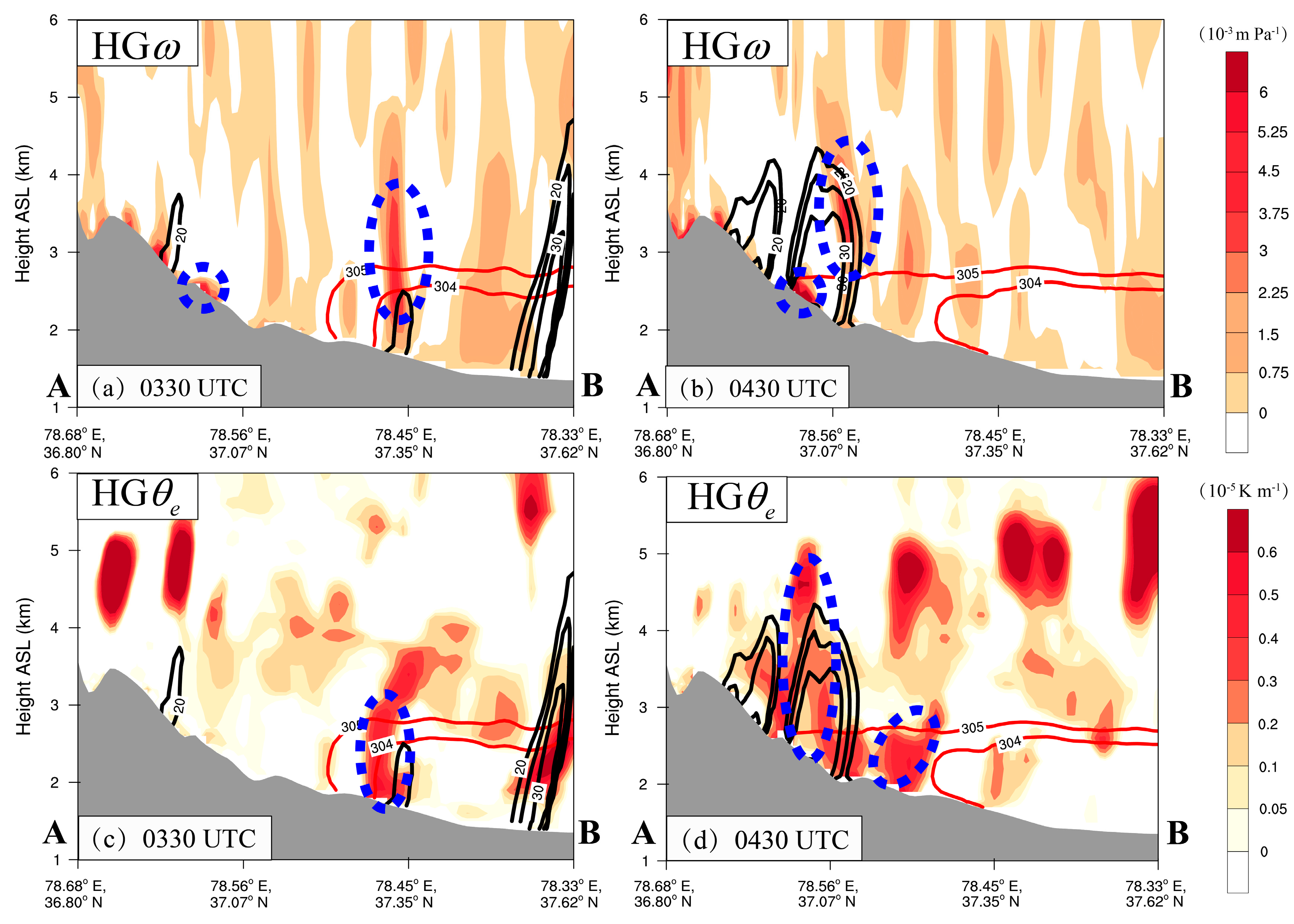
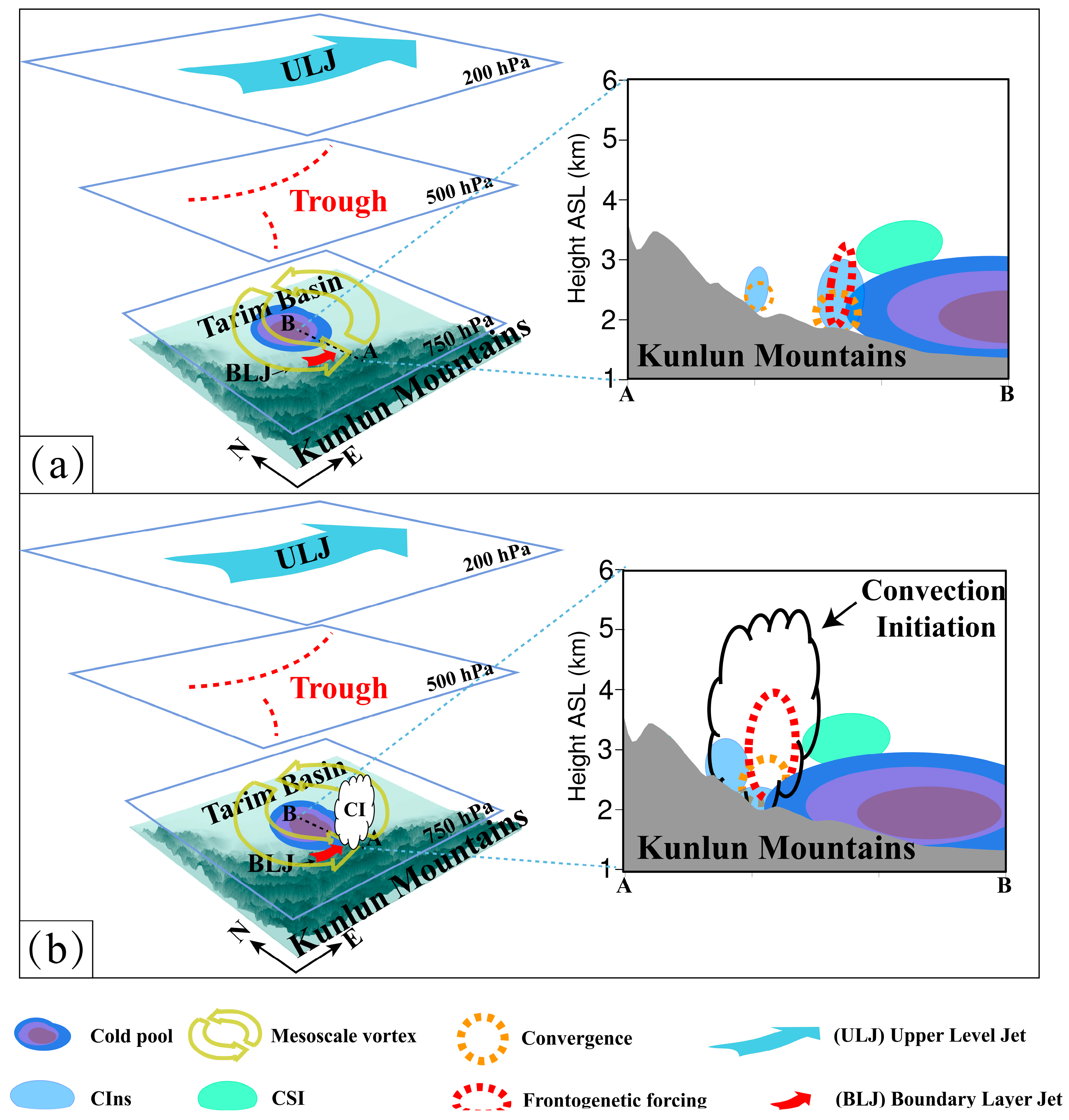
Disclaimer/Publisher’s Note: The statements, opinions and data contained in all publications are solely those of the individual author(s) and contributor(s) and not of MDPI and/or the editor(s). MDPI and/or the editor(s) disclaim responsibility for any injury to people or property resulting from any ideas, methods, instructions or products referred to in the content. |
© 2023 by the authors. Licensee MDPI, Basel, Switzerland. This article is an open access article distributed under the terms and conditions of the Creative Commons Attribution (CC BY) license (https://creativecommons.org/licenses/by/4.0/).
Share and Cite
Sun, Q.; Abulikemu, A.; Yao, J.; Mamtimin, A.; Yang, L.; Zeng, Y.; Li, R.; An, D.; Li, Z. A Case Study on the Convection Initiation Mechanisms of an Extreme Rainstorm over the Northern Slope of Kunlun Mountains, Xinjiang, Northwest China. Remote Sens. 2023, 15, 4505. https://doi.org/10.3390/rs15184505
Sun Q, Abulikemu A, Yao J, Mamtimin A, Yang L, Zeng Y, Li R, An D, Li Z. A Case Study on the Convection Initiation Mechanisms of an Extreme Rainstorm over the Northern Slope of Kunlun Mountains, Xinjiang, Northwest China. Remote Sensing. 2023; 15(18):4505. https://doi.org/10.3390/rs15184505
Chicago/Turabian StyleSun, Qi, Abuduwaili Abulikemu, Junqiang Yao, Ali Mamtimin, Lianmei Yang, Yong Zeng, Ruqi Li, Dawei An, and Zhiyi Li. 2023. "A Case Study on the Convection Initiation Mechanisms of an Extreme Rainstorm over the Northern Slope of Kunlun Mountains, Xinjiang, Northwest China" Remote Sensing 15, no. 18: 4505. https://doi.org/10.3390/rs15184505





